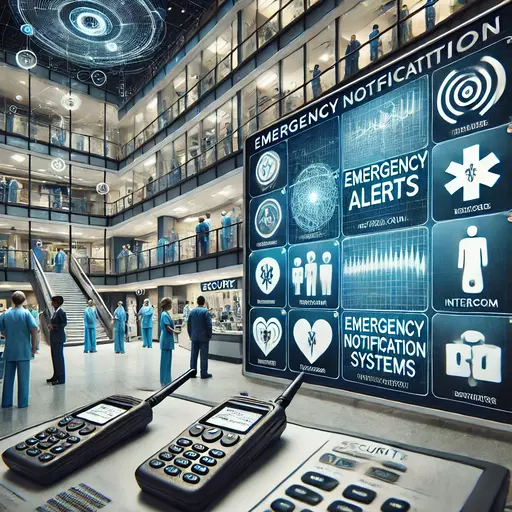
In healthcare, where every second counts, reliable emergency communication systems are vital. These systems aren’t just tools; they’re lifelines that enable hospitals and healthcare facilities to respond efficiently to emergencies, ensuring the safety of patients, staff, and visitors. By investing in advanced communication solutions, healthcare providers can mitigate risks, improve operational continuity, and maintain a safe environment for everyone. This article explores the critical role of emergency communication systems in healthcare, highlighting their benefits, key components, and unique contributions to patient care and safety.
Why Emergency Communication Systems Are Crucial in Healthcare
Healthcare facilities face unique demands when it comes to emergency response:
24/7 Operations: Healthcare is a continuous service that requires seamless communication at all hours.
High-Stakes Scenarios: Life-threatening emergencies, natural disasters, or security threats need immediate action.
Compliance and Security: Patient information and operational details must be protected, adhering to HIPAA and other healthcare regulations.
With these demands, an effective emergency communication system must deliver reliable, secure, and fast information to allow for rapid, coordinated responses. Failure in communication during a critical moment could mean the difference between life and death.
Key Components of Effective Healthcare Emergency Communication Systems
An optimal emergency communication system integrates several elements tailored to healthcare’s unique needs:
- Mass Notification Systems
When an emergency occurs, healthcare facilities need to inform staff and patients immediately across various channels: text, phone, email, and PA systems. Mass notification systems are designed to ensure that everyone is aware of the situation, preventing confusion and facilitating prompt action.
- Two-Way Communication Features
Emergencies are unpredictable, often requiring quick feedback and adjustments. Two-way communication allows responders to stay updated and adapt plans as the situation unfolds, creating an agile response that can save lives and minimize disruption.
- Integration with Existing Security and Safety Systems
Modern emergency communication systems are designed to work alongside security alarms, surveillance systems, and access control tools. By linking communication with these systems, healthcare facilities can maintain control over the environment and respond holistically to emergencies.
- Location-Based Alerts and Geofencing
In large hospitals, knowing exactly where an incident is occurring is crucial. Location-based alerting enables targeted communications to reach specific areas, ensuring that the right staff can act immediately while others continue their work without interruption.
- Backup and Redundancy Systems
Power outages and technical failures are inevitable. Emergency communication systems with backup power and redundant pathways ensure that critical messages are delivered, even if one part of the system fails.
The Benefits of Emergency Communication Systems for Healthcare Facilities
Implementing a robust emergency communication system offers numerous advantages that support healthcare’s core mission of saving lives and maintaining safe operations.
- Enhanced Patient Safety
In any healthcare emergency, patient safety is the highest priority. Emergency communication systems help ensure that staff receive immediate alerts, allowing for swift evacuation, lockdowns, or rerouting of patients as needed. These actions can prevent harm, particularly for vulnerable patients in ICUs, operating rooms, or neonatal units.
- Streamlined Staff Coordination and Improved Response Time
An emergency communication system provides an organized way to coordinate efforts across departments and facilities. Staff can receive specific instructions based on their role or location, minimizing confusion and reducing the time it takes to execute emergency procedures.
- Operational Continuity in Crisis Situations
Healthcare facilities cannot afford to stop operations during emergencies. Emergency communication systems support continuity, helping staff manage unexpected challenges without impacting patient care. By automating certain responses and streamlining communication, healthcare facilities can maintain stability and continue critical operations.
- Compliance with Regulatory Standards
Healthcare regulations like those from CMS and The Joint Commission mandate emergency preparedness protocols. Emergency communication systems enable facilities to meet these compliance standards, improving readiness for events ranging from natural disasters to active shooter situations.
- Positive Patient Experience and Reputation
Families want assurance that their loved ones are in a safe, prepared environment. Emergency preparedness enhances a facility’s reputation and builds trust with patients and their families, who feel more comfortable knowing that the hospital has robust procedures to manage emergencies effectively.
SSP’s Commitment to Healthcare Emergency Communication Solutions
At SSP (Southeastern Security Professionals), we recognize the pivotal role of reliable emergency communication systems in healthcare environments. Our solutions offer:
Scalable Mass Notification Systems to reach all areas of your facility within seconds.
Two-Way Communication Features that enable real-time updates and responsive actions during emergencies.
Seamless Integration with existing security, surveillance, and access control systems for a comprehensive approach.
Our goal is to help healthcare facilities stay prepared for any scenario, ensuring safety and operational continuity.
Building a Safer Healthcare Environment with Emergency Communication
The right emergency communication system transforms healthcare facilities into safe, responsive environments where emergencies are met with swift, organized responses. Whether it’s a natural disaster, security threat, or medical emergency, these systems enable healthcare providers to prioritize safety and continue delivering essential care.
At SSP, we’re dedicated to helping healthcare organizations implement the best possible emergency communication solutions. Contact us to learn how our integrated systems can support your facility’s safety and readiness goals.


